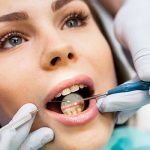Dental Hygiene – How a Dental Hygienist Can Help With Oral Health (Part 1)
Call us on 0208 616 0590 or email us at [email protected] to book an appointment.
Dental Hygiene – Why Is It Required?
Dental hygiene is the practice for maintaining oral health by keeping the mouth clean and free of diseases. The most common types of diseases that can occur are tooth decay (also called cavities or dental caries) and gum diseases. It is important that dental hygiene be carried out regularly in order to prevent these dental diseases and other problems such as bad breath from arising.
Plague
Dental plaque, also sometimes referred to as dental biofilm, is a sticky yellow coloured film composed of a range of bacteria, which attaches itself to tooth surfaces. It is usually visible around the gum line. It starts to appear once the tooth surface has been cleaned. A high-sugar diet encourages the growth and formation of dental plaque. Plague converts the sugar into acid; the acid then causes the breakdown of the adjacent tooth, likely leading to tooth decay.
If plaque is left under the surface of the gum undisturbed, the risk of tooth decay increases. In addition, it will also irritate the gums and make them appear red and swollen. Bleeding could occur during tooth brushing or flossing. These signs of inflammation are an indicator of poor gum health.
Calculus (Or Tartar)
The longer that dental plaque stays on the tooth surface, the harder and more attached to the tooth it gets. At this stage, plaque is then referred to as calculus and needs to be removed by a dental professional, usually a dentist or hygienist. If calculus is left untreated, the resulting inflammation can lead to loss of bone structure and will likely lead to loosening of the affected teeth.
Tooth Decay
Decay or caries (or cavities) is a disease of the mouth that leads to breakdown of the tooth due to acids produced by bacteria in the mouth. A cavity may be a number of different colours – it could be yellow or also black. Symptoms of tooth decay can include pain and difficulty with eating. Complications can arise from tooth decay – for example tooth decay could lead to inflammation of the tissue surrounding the tooth, loss of tooth, and abscess formation. A vast majority of cavities occur in areas where brushing cannot reach trapped food and where saliva and fluoride (from tooth pastes/water) have no access to neutralize acid and remineralise teeth. The primary cause of caries is acid from bacteria dissolving the hard tissues of the teeth. Caries are usually associated with poor oral hygiene.
Gum Disease
Gum disease, also called Periodontal disease, is a set of conditions related to inflammation of the tissue surrounding the teeth. In its early stages, the gums become swollen, red, and may bleed. In later stages of gum disease, in its more serious form, the gums could pull away from the tooth, bone structure can be lost or reduce, and the teeth may loosen, even potentially fall out. Bad breath could potentially also occur.
Gum disease is usually due to bacteria in the mouth, where it infects the tissue around the teeth. Poor oral hygiene, smoking, diabetes, family history and certain medications are usually associated with it. Treatment involves good oral hygiene and regular professional. Daily brushing and flossing clearly help with treatment.
In the next part of the series, we will discuss various treatment options available to patients. Enlighten Home Whitening can whiten up to 16 shades. Results vary, but if used correctly all teeth will whiten dramatically.
Natural teeth rarely look too white. Sometimes very white crowns can look wrong because they are made of porcelain
Please visit our Whites Dental website at www.whitesdental.co.uk for more details about our dental hygienist treatments. We will be more than happy to assist with brightening your smile.


